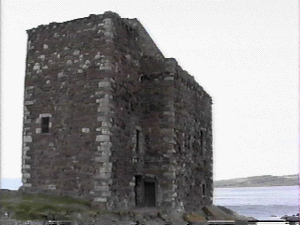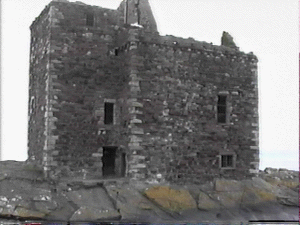

Portencross Castle is the fourth Boyd castle or tower house that we have been able to identify. This castle was the traditional place of departure from the mainland for the funeral boats carrying the kings of Scotland to burial on the Holy island of Iona. There is a rare blue flower found there which is associated with both the castle and its sometimes sad function. This history is remembered in a song called "The Flower of Portencross."
When we arrived at its location near West Kilbride we found it conveniently adjacent to a public car park, set aside for local recreational use. The keep itself sits astride a rock which projects into the Firth of Clyde. It is the smallest of the Boyd towers that we visited, though it is probably the oldest.
The keep originally belonged to the Ross family, who backed the wrong side in the Bruce/Comlyn dispute. It already stood when the victorious King gave it to Sir Robert Boyd along with the better known holdings in Strathclyde. Although in a now remote location and small in size, it played an important part in the history of the region. Several of the Stewart kings stayed in the keep on their travels through the area and existing documents were signed and dated by them there. It passed out of the Boyd family in 1785 after over 400 years of ownership.
The structure is of red sandstone and comprised of a square three storied tower, the oldest part, containing a door at ground level on the East (landward side), and a later four story tower which was added to the East side to form a re-entrant angle. As can be seen from the picture above, there is an additional door in the new tower which faces the one in the older construction. This door has a square lintel, whereas the older one is arched. The parapets are supported on individual corbels. There are no rounds at the corners.
We had full access to the outside of the castle, but found the doors secured by padlocks. The keep is unoccupied at present. The following description of the interior comes from "Castles of Scotland", by Maurice Lindsay, published 1994 by Constable and Company, Ltd., London. "there is a kitchen in the vaulted basement with a straight stair to the first floor, and in the linking wall of the two sections, a turnpike stair beyond. The Hall in the main block is vaulted, with an entresol floor at the base of the vaulting. There is an additional kitchen at first-floor level. The higher part of the building is now ruinous, having stood exposed to the elements since a gale stripped its roof in 1739." This source also states that the second door (in the wing) leads to the first floor. Americans should remember that the "first floor" in Scotland refers to what is commonly called the "second floor" in the USA. Our first floor is called the "ground Floor" there.
The design of the castle incorporates features which are atypical of tower houses of the late thirteenth and fourteenth centuries, from which the oldest part of this building must date, having been given as an existing structure to Sir Robert Boyd by King Robert the Bruce. The usual location of the entrance would have been at the first floor level, as evidenced at Kilmarnock (Dean) Castle. Access was made via a ladder which was drawn up when the door was secured.
If we imagine the appearance of the older tower without the new addition and ground level door, it is in all other aspects typical of the period. We surmise that the door was moved to ground level when the new tower was built, perhaps in the fifteenth or sixteenth centuries when ground floor entrances had become common. The original entrance is now most likely the passage at the first floor level between the two towers. The additional door in the new tower was probably added at an even later date, as indicated by the differing methods of construction of the two portals.

Life in this sea level keep must have been excruciatingly unpleasant during winter storms, It is directly exposed to both wind and waves and sits less than ten feet from the water's edge. Flood tide waves would reach the ground floor easily (note that the picture was taken when the tide was out) and blowing spume and water would readily drench the upper two floors. This certainly explains the presence of an alternate kitchen on the first floor for use when the ground floor was too wet. Everything and everybody in residence would soon be damp and clammy. That such a location would be built and occupied for so long a period serves to remind us of the violence our ancestors endured without the protection of civilized government not so very long ago.